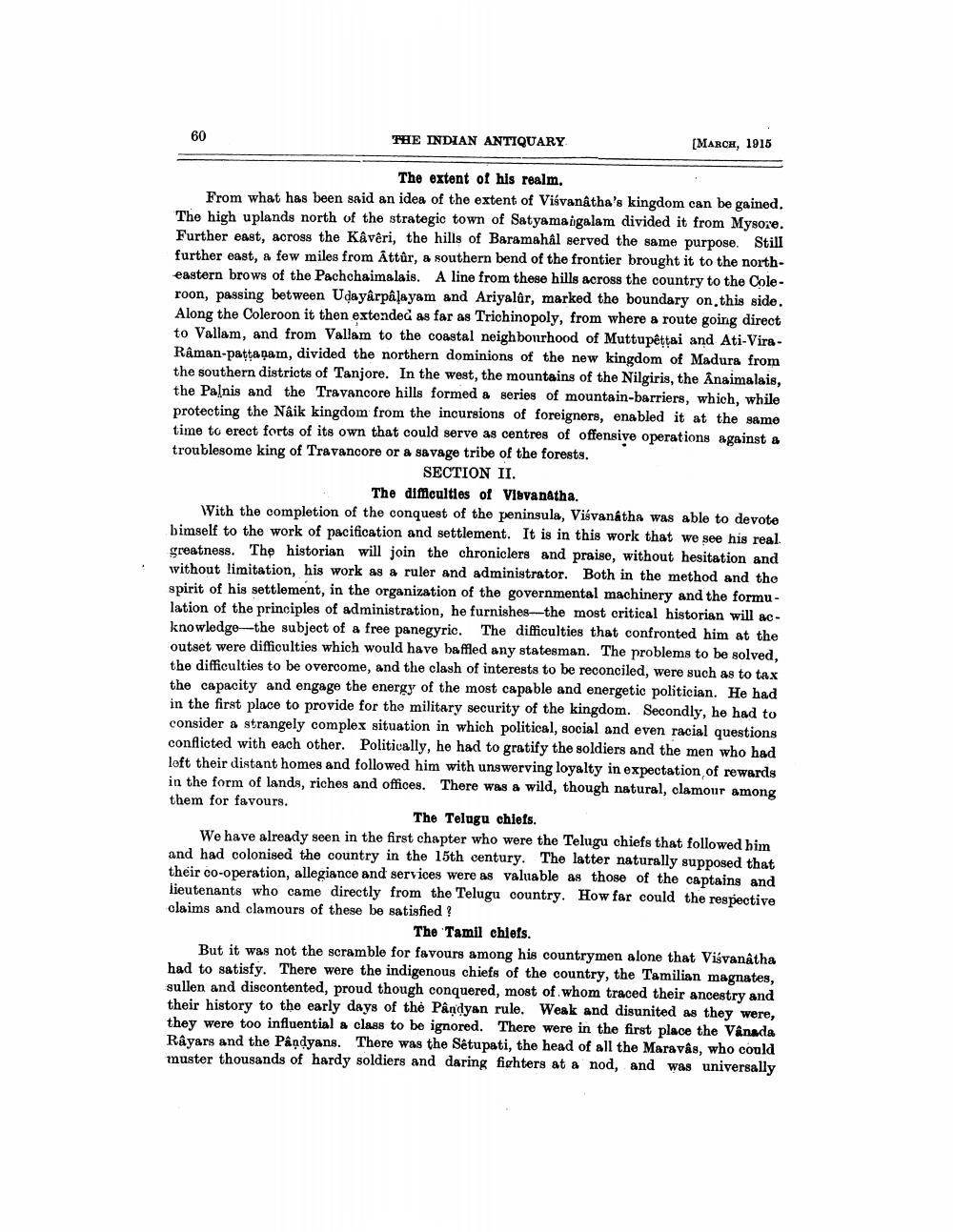________________
ME INDIAN ANTIQUARY
[MARCH, 1915
The extent of his realm. From what has been said an idea of the extent of Visvanatha's kingdom can be gained. The high uplands north of the strategic town of Satyamangalam divided it from Mysore. Further east, across the Kêvêri, the hills of Baramahal served the same purpose. Still further east, a few miles from Attûr, a southern bend of the frontier brought it to the northeastern brows of the Pachchaimalais. A line from these hills across the country to the Coleroon, passing between Udayârpalayam and Ariyalûr, marked the boundary on this side. Along the Coleroon it then extended as far as Trichinopoly, from where a route going direct to Vallam, and from Vallam to the coastal neighbourhood of Muttupettai and Ati-ViraRâman-pattanam, divided the northern dominions of the new kingdom of Madura from the southern districts of Tanjore. In the west, the mountains of the Nilgiris, the Anaimalais, the Palnis and the Travancore hills formed a series of mountain-barriers, which, while protecting the Nâik kingdom from the incursions of foreigners, enabled it at the same time to erect forts of its own that could serve as centres of offensive operations against a troublesome king of Travancore or a savage tribe of the forests.
SECTION II.
The difficulties of Visvanatha. With the completion of the conquest of the peninsula, Visvanatha was able to devote bimself to the work of pacification and settlement. It is in this work that we see his real greatness. The historian will join the chroniclers and praise, without hesitation and without limitation, his work as a ruler and administrator. Both in the method and the spirit of his settlement, in the organization of the governmental machinery and the formulation of the principles of administration, he furnishes--the most critical historian will acknowledge the subject of a free panegyric. The difficulties that confronted him at the outset were difficulties which would have baffled any statesman. The problems to be solved, the difficulties to be overcome, and the clash of interests to be reconciled, were such as to tax the capacity and engage the energy of the most capable and energetic politician. He had in the first place to provide for the military security of the kingdom. Secondly, he had to consider a strangely complex situation in which political, social and even racial questions conflicted with each other. Politically, he had to gratify the soldiers and the men who had left their distant homes and followed him with unswerving loyalty in expectation of rewards in the form of lands, riches and offices. There was a wild, though natural, clamour among them for favours.
The Telugu chiefs. We have already seen in the first chapter who were the Telugu chiefs that followed him and had colonised the country in the 15th century. The latter naturally supposed that their co-operation, allegiance and services were as valuable as those of the captains and lieutenants who came directly from the Telugu country. How far could the respective claims and clamours of these be satisfied ?
The Tamil chiefs. But it was not the scramble for favours among his countrymen alone that Visvanatha had to satisfy. There were the indigenous chiefs of the country, the Tamilian magnates, sullen and discontented, proud though conquered, most of whom traced their ancestry and their history to the early days of the Pândyan rule. Weak and disunited as they were, they were too influential a class to be ignored. There were in the first place the Vánada Rêyars and the Pandyans. There was the Setupati, the head of all the Maravâs, who could muster thousands of hardy soldiers and daring fighters at a nod, and was universally




